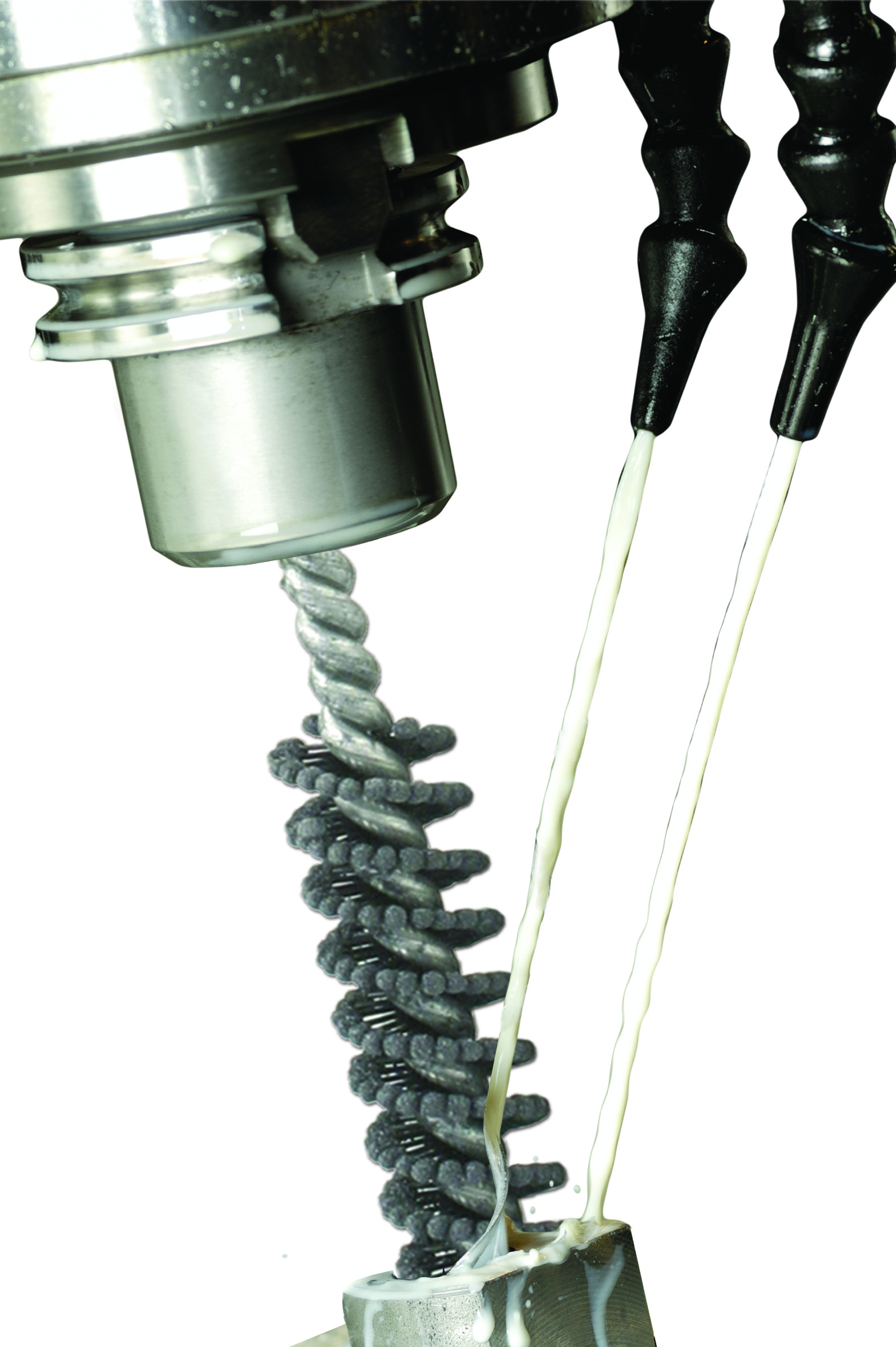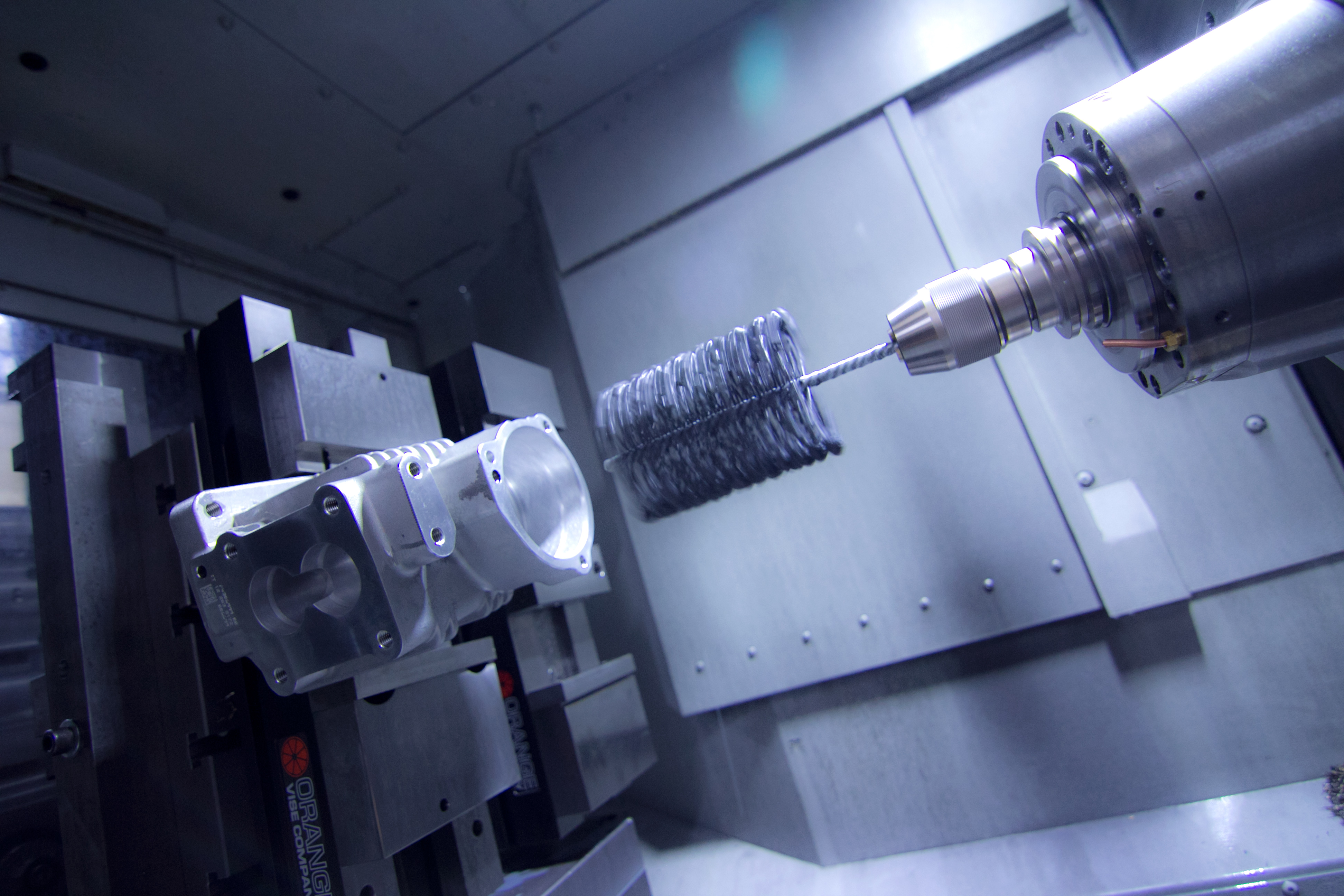 With new advances in abrasive technology, machining center operators are able to complete surface finishing simultaneously with other machining operations, to speed cycle times, improve quality and save on off-line finishing time and costs. The abrasive finishing tools can be easily integrated into CNC machines carousels or tool holding systems.
With new advances in abrasive technology, machining center operators are able to complete surface finishing simultaneously with other machining operations, to speed cycle times, improve quality and save on off-line finishing time and costs. The abrasive finishing tools can be easily integrated into CNC machines carousels or tool holding systems.
While contract machine shops are increasingly turning to these tools, others worry about the use of abrasive materials in expensive CNC machining centers. The concern is often a generalized impression that “abrasives” – like sandpaper – release large amounts of grit and debris that could clog coolant lines or damage exposed slides or bearings. These concerns are largely unfounded.
“These are very expensive, very accurate machines,” said Janos Garaczi, president of Delta Machine Company, LLC, a machine shop specializing in complex, tight tolerance parts made of titanium, nickel alloys, stainless steel, aluminum, plastics and other exotic alloys. “I wouldn’t do anything to jeopardize the accuracy or lifespan of the equipment.”
The misconception is that “abrasives” are the same. However, a distinction must be made between abrasives used for aggressive material removal and abrasive finishing tools. Finishing tools release little to no abrasive grit during use, and the amount generated is comparable to the metal chips, grinding dust and tool abrasion created during the machining process itself.
Even if minimal fine solids are produced, the filtration requirements for abrasive tools are not much different than for machining. Any particulate can be easily removed using inexpensive bag or cartridge filtration systems, said Jeff Brooks of Filtra Systems, a company specializing in industrial filtration systems including for CNC coolant.
According to Tim Urano, quality manager at Wolfram Manufacturing, any additional cost for filtration related to the use of abrasive tools is so negligible it is “not really a consideration because filtration systems are already required to remove particulate from the coolant generated during the machining process itself.”
For the past eight years, Wolfram Manufacturing has incorporated the Flex-Hone in all CNC machines for cross-hole deburring and surface finishing. The Flex-Hone from Los Angeles-based Brush Research Manufacturing (BRM) is characterized by the small, abrasive globules that are permanently mounted to flexible filaments, the product is a flexible, low cost tool utilized for sophisticated surfacing, deburring and edge-blending.
 Removal of burrs and sharp edges in cross-drilled holes and other difficult-to-access areas such as undercuts, grooves, slots, or internal holes is critical. Failing to remove burrs can cause blockages or create turbulence in the flow of fluids, lubricants and gases through critical passages.
Removal of burrs and sharp edges in cross-drilled holes and other difficult-to-access areas such as undercuts, grooves, slots, or internal holes is critical. Failing to remove burrs can cause blockages or create turbulence in the flow of fluids, lubricants and gases through critical passages.
“On a given part, we might deploy two to three different size Flex-Hones, depending on the number of cross port intersections and different hole sizes,” explains Urano.
The Flex-Hones are added to the tool carousel and are used daily, usually several times an hour, on some of the shop’s highest volume parts.
“The volume of abrasives that could even possibly come off of the Flex-Hone is insignificant compared to the rest of the particulate that gets into the coolant,” explains Urano.
Abrasive Nylon Filaments
For Eric Sun, founder of Orange Vise Company in Orange County, California, even cutting tools such as carbide drills and end mills can create debris that must be filtered from the coolant.
“Some machine shops might say, ‘I don’t use any abrasives in my process; therefore, my machine is completely free of all particulate matter,’ but that is not the case. Even cutting tools can wear down and the carbide can come loose and get into the coolant,” says Sun.
Although Orange Vise is a contract manufacturer, the company primarily machines vises and quick-change fixturing components used in CNC machines out of aluminum, steel and cast iron. The company utilizes four Mori Seiki NHX4000 high speed horizontal machining centers and two vertical machining centers.
According to Sun, many of the vises are made of cast iron with selectively hardened surfaces. To match the surface finish of the hardened surfaces, Orange Vise uses NamPower abrasive disc brushes from Brush Research.
Composed of flexible abrasive nylon filaments bonded to a fiber reinforced thermoplastic base, the NamPower abrasive disc brushes contain a unique combination of both ceramic and silicon carbide abrasive. The abrasive filaments work like flexible files, conforming to part contours, wiping and filing across part edges and surfaces to deliver maximum burr removal rates along with an ideal surface finish. Other common uses are edge blending, part cleaning, and rust removal.
To complete the surface finishing operation, abrasive nylon brushes are installed in the tool loading system of each CNC machine. Although abrasive grit is involved, Sun says the NamPower brush is a “different type of abrasive” because it is essentially “self-sharpening.” Because of its linear construction, sharp new grains constantly come in contact with the work surface and wear off exposing fresh cutting particles.
“We have used the NamPower abrasive nylon brushes daily for six years. During that time, we have had no issues with any sort of particulate or grit getting into any critical surfaces,” adds Sun. “In our experience, any small amount of grit created is a non-issue.”
Contact Details
Related Glossary Terms
- abrasive
abrasive
Substance used for grinding, honing, lapping, superfinishing and polishing. Examples include garnet, emery, corundum, silicon carbide, cubic boron nitride and diamond in various grit sizes.
- alloys
alloys
Substances having metallic properties and being composed of two or more chemical elements of which at least one is a metal.
- burr
burr
Stringy portions of material formed on workpiece edges during machining. Often sharp. Can be removed with hand files, abrasive wheels or belts, wire wheels, abrasive-fiber brushes, waterjet equipment or other methods.
- centers
centers
Cone-shaped pins that support a workpiece by one or two ends during machining. The centers fit into holes drilled in the workpiece ends. Centers that turn with the workpiece are called “live” centers; those that do not are called “dead” centers.
- computer numerical control ( CNC)
computer numerical control ( CNC)
Microprocessor-based controller dedicated to a machine tool that permits the creation or modification of parts. Programmed numerical control activates the machine’s servos and spindle drives and controls the various machining operations. See DNC, direct numerical control; NC, numerical control.
- coolant
coolant
Fluid that reduces temperature buildup at the tool/workpiece interface during machining. Normally takes the form of a liquid such as soluble or chemical mixtures (semisynthetic, synthetic) but can be pressurized air or other gas. Because of water’s ability to absorb great quantities of heat, it is widely used as a coolant and vehicle for various cutting compounds, with the water-to-compound ratio varying with the machining task. See cutting fluid; semisynthetic cutting fluid; soluble-oil cutting fluid; synthetic cutting fluid.
- filing
filing
Operation in which a tool with numerous small teeth is applied manually to round off sharp corners and shoulders and remove burrs and nicks. Although often a manual operation, filing on a power filer or contour band machine with a special filing attachment can be an intermediate step in machining low-volume or one-of-a-kind parts.
- grinding
grinding
Machining operation in which material is removed from the workpiece by a powered abrasive wheel, stone, belt, paste, sheet, compound, slurry, etc. Takes various forms: surface grinding (creates flat and/or squared surfaces); cylindrical grinding (for external cylindrical and tapered shapes, fillets, undercuts, etc.); centerless grinding; chamfering; thread and form grinding; tool and cutter grinding; offhand grinding; lapping and polishing (grinding with extremely fine grits to create ultrasmooth surfaces); honing; and disc grinding.
- machining center
machining center
CNC machine tool capable of drilling, reaming, tapping, milling and boring. Normally comes with an automatic toolchanger. See automatic toolchanger.
- tolerance
tolerance
Minimum and maximum amount a workpiece dimension is allowed to vary from a set standard and still be acceptable.
- turning
turning
Workpiece is held in a chuck, mounted on a face plate or secured between centers and rotated while a cutting tool, normally a single-point tool, is fed into it along its periphery or across its end or face. Takes the form of straight turning (cutting along the periphery of the workpiece); taper turning (creating a taper); step turning (turning different-size diameters on the same work); chamfering (beveling an edge or shoulder); facing (cutting on an end); turning threads (usually external but can be internal); roughing (high-volume metal removal); and finishing (final light cuts). Performed on lathes, turning centers, chucking machines, automatic screw machines and similar machines.
